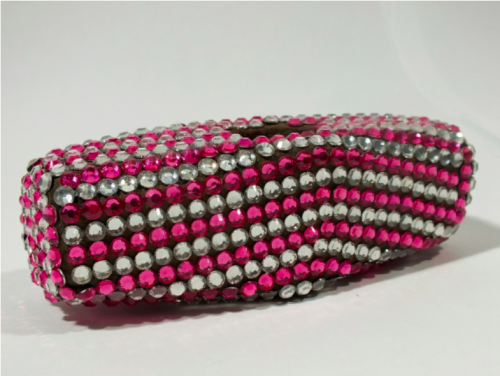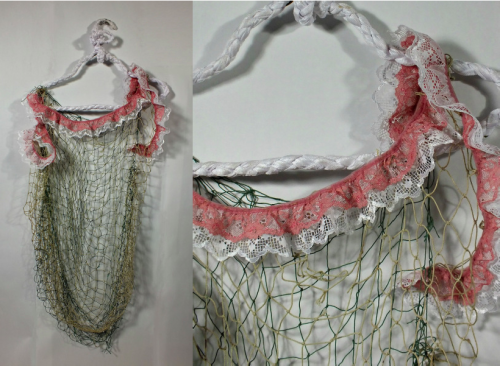Stéphanie McKnight (Stéfy) is a MA candidate in Cultural Studies at Queen’s University. Initially from northern Ontario, Stéfy began her career as a visual artist while undergoing a Bachelor of Fine Arts at Nipissing University in North Bay. Interested in how cultural themes relates to ideas of social construction, her research focuses on social sorting, gender performativity, and surveillance post Edward Snowden (2013). Her primary artist medium is installation art in forms such as site specific, video and media; performance and found object related installations.

UNE SCIE (2013)
In its disruption of a conventional domestic scene, your video installation Dining Room Table: Hammering Out Gender Performativity brings to mind earlier feminist interventions into the nature of “women’s roles,” including Martha Rosler’s “Semiotics of the Kitchen” (1975). What prompted your engagement with the politics of the domestic sphere? What, for you, is the most pressing aspect of this issue in our 21st century moment?
So, I’m 23 – which means I’ve never had to live through some of the hardest years in women’s history. I missed the 20’s and 50’s, and although I’m thankful that I haven’t had to experience their hardship, I often catch myself thinking about my experience as a young feminist in comparison to theirs. Women’s rights have changed for the good, though it’s important to realize that issues change with time. Some of the issues we have to contend with today didn’t exist 50 years ago. This is what the video attempts to portray. It looks at 3 time periods: then, now and the future. As people we need to look at social issues in comparison to the culture we live in at the time.
I think what is most important about the video is the workbench. No matter what anyone reads in to it, it is really what makes the piece. Imagine having a 1950s housewife building a table by hand, without instructions, in the middle of the most historically ‘feminized’ room in the home? That would never happen. Today it can. The larger context is, yes I can build a workbench in a kitchen and I have the freedom to do so, but what are the other problems I have to deal with today: Abortion, body shaming, rape culture, cyber bullying?
What’s important about the kitchen is it is a modern 21st century kitchen. There’s a microwave, toaster, coffee maker… I know for a fact that my partner won’t cook for himself, but he’s a chef when it comes to pizza pockets in the microwave. Domestic settings have changed dramatically since the introduction of technology. Even our coffee makers have barcodes. I’m currently contending with how technology shifts domestic settings and roles.
As abstract as this blog submission sounds, this is how I imagined the video: an abstract rendition of questions through visual imagery. There’s no real answers in this video, only questions. I want my viewers to question and contend with some of the questions I’m looking at. It’s a conversation starter… So let’s have this conversation.

TETE DE MARTEAU (2013)
In your artist’s statement, you mention your interest in the younger generation’s engagement with feminism. Thanks to internet culture, the feminist conversation has been both spotlighted and marked by violent attacks (the Gamergate victims, for example). Though it’s impossible to speak about feminism as a singular phenomenon, what, for you, are some of the challenges facing a younger generation who may or may not want to join this conversation?
I’m very interested in how young women and men understand feminism today. I’ve frequently asked the students I TA, do you think feminism is important? Why do you think we need to talk about it? They honestly have no idea. I even began asking 7-9th graders and they rarely reply confidently. I constantly get responses like “we’re in school so we don’t need it”, “we have the right to vote”, “I like men so I’m not a feminist”. But they really don’t talk about the contemporary issues, such as wage gap, body shaming and intersexuality.
The Internet is definitely one of the reasons we’re having these issues. Feminism is portrayed in so many different ways. Even celebrities who say they are feminist don’t always think about intersectionality, race or queer theory – I can definitely see why youth are so confused about what it is to be feminist.
They also don’t learn about in school. I don’t like talking about high school and elementary curriculum but it is very conservative (we all know it). The extent I remember learning in high school was the date women had the right to vote.
The challenge facing younger generation is the lack of conversation. We should be having these conversations in school, with boys and girls and everyone. It’s not the youth’s fault. They learn what you teach them. They take what they want but they learn from what they hear, see and experience. Systems that allow for these conversations need to be put in place.
The work I do attempt to create these conversations without showing them images of vaginas and dicks (not that this is a problem). I like to be subtle first, and then get into the gritty once I’ve lured them in. This definitely works from my experience teaching them.
I think it’s funny that the question asks what are the challenges of having younger generations joining the conversation – lets organize places where we can have these conversations.

ROBE (2013)
To find more of Stéphy’s work, visit her website.





